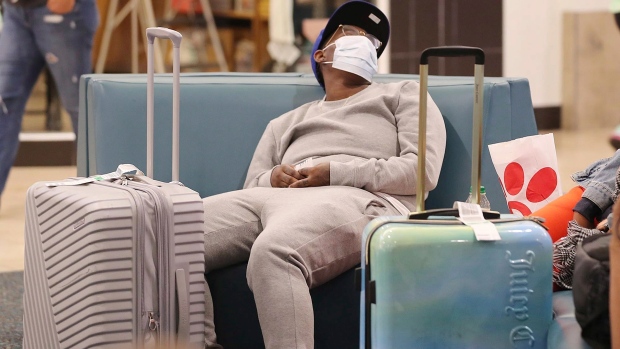MIAMI — Thousands of people were confined Saturday to a cruise ship circling in international waters off the San Francisco Bay Area, after 21 passengers and crew members tested positive for the new coronavirus.
The Grand Princess was forbidden to dock in San Francisco amid evidence that the vessel had been the breeding ground for a cluster of more than 10 cases that resulted in at least one death after its previous voyage.
Meanwhile, Florida reported two coronavirus deaths – the first outside the West Coast. Health officials said the people in their 70s died in Santa Rosa County in Florida’s Panhandle and in the Fort Myers area after travelling overseas. Florida also raised the number of people who have tested positive for COVID-19 – the disease caused by the coronavirus – from four to seven.
The U.S. death toll from the virus climbed to 16, with all but three victims in Washington state. The number of infections swelled to more than 200, scattered across about half of the U.S. states. Pennsylvania, Indiana, Minnesota and Nebraska have reported their first cases.
In California, state authorities were working with federal officials around-the-clock to bring the Grand Princess cruise ship to a non-commercial port over the weekend and test everyone for the virus. There was no immediate word on where the vessel will dock.
Two passengers on the ship said Friday night that the captain has notified them that they were moving to a location 20 miles off the coast for easier delivery of supplies. The captain said a guest required medical attention and might be airlifted out, the passengers said.
While health officials said about 1,100 crew members will remain aboard, passengers could be disembarked to face quarantine, possibly at U.S. military bases or other sites. That’s what happened to hundreds of passengers who were exposed to the virus on another cruise ship in January.
“Those that will need to be quarantined will be quarantined. Those who will require medical help will receive it,” Vice-President Michael Pence said Friday as he announced that 19 crew members and two passengers had tested positive for COVID-19.
President Donald Trump, speaking Friday at the U.S. Centers for Disease Control and Prevention in Atlanta, said he would prefer not to allow the passengers onto American soil but will defer to the recommendations of medical experts.
“They would like to have the people come off. I’d rather have the people stay but … I told them to make the final decision,” the president said.
“I don’t need to have the numbers (of U.S. cases) double because of one ship that wasn’t our fault,” Trump said while touring the CDC in Atlanta. “And it wasn’t the fault of the people on the ship either. Okay? It wasn’t their fault either. And they are mostly American, so I can live either way with it.”
Passengers aboard the Grand Princess remained holed up in their rooms as they awaited word about the fate of the ship. Some said ship officials only informed them of the confirmed coronavirus cases after they first learned about it from news reports.
Steven Smith and his wife, Michele, of Paradise, California, went on the cruise to celebrate their wedding anniversary.
The Smiths said they were a bit worried but felt safe in their room, which they had left just once since Thursday to video chat with their children.
Crew members wearing masks and gloves delivered trays with their food in covered plates and left them outside their door.
To pass the time they have been watching television, reading and looking out the window.
“Thank God, we have a window!” Steven said.
The ship was heading from Hawaii to San Francisco when it was held off the California coast Wednesday so 46 people with possible coronavirus symptoms could be tested. On Thursday, a military helicopter crew lowered test kits onto the 951-foot (290-meter) ship by rope and later flew them for analysis at a state lab.
Health officials undertook the testing after reporting that a 71-year-old man who had been on a February voyage of the same ship to Mexico contracted the virus and died this week at a hospital in Placer County in Northern California. Others who were on that voyage also have tested positive in Northern California, Minnesota, Illinois, Hawaii, Utah and Canada. A “presumed positive” patient was self-isolating at home in Nevada, health officials there said.
Health officials confirmed another case in California on Saturday involving a Madera County resident who developed symptons after returning from a Princess cruise.
Some passengers who had been on the Mexico trip stayed aboard for the current voyage – increasing crew members’ exposure to the virus.
Another Princess ship, the Diamond Princess, was quarantined for two weeks in Yokohama, Japan, last month because of the virus. Ultimately, about 700 of the 3,700 people aboard became infected in what experts pronounced a public-health failure, with the vessel essentially becoming a floating germ factory.
Hundreds of Americans aboard that ship were flown to military bases in California and other states for two-week quarantines. Some later were hospitalized with symptoms.
An epidemiologist who studies the spread of virus particles said the recirculated air from a cruise ship’s ventilation system, plus the close quarters and communal settings, make passengers and crew vulnerable to infectious diseases.
“They’re not designed as quarantine facilities, to put it mildly,” said Don Milton of the University of Maryland.
Worldwide, the virus has infected more than 100,000 people and killed over 3,400, the vast majority of them in China. Most cases have been mild, and more than half of those infected have recovered.


























